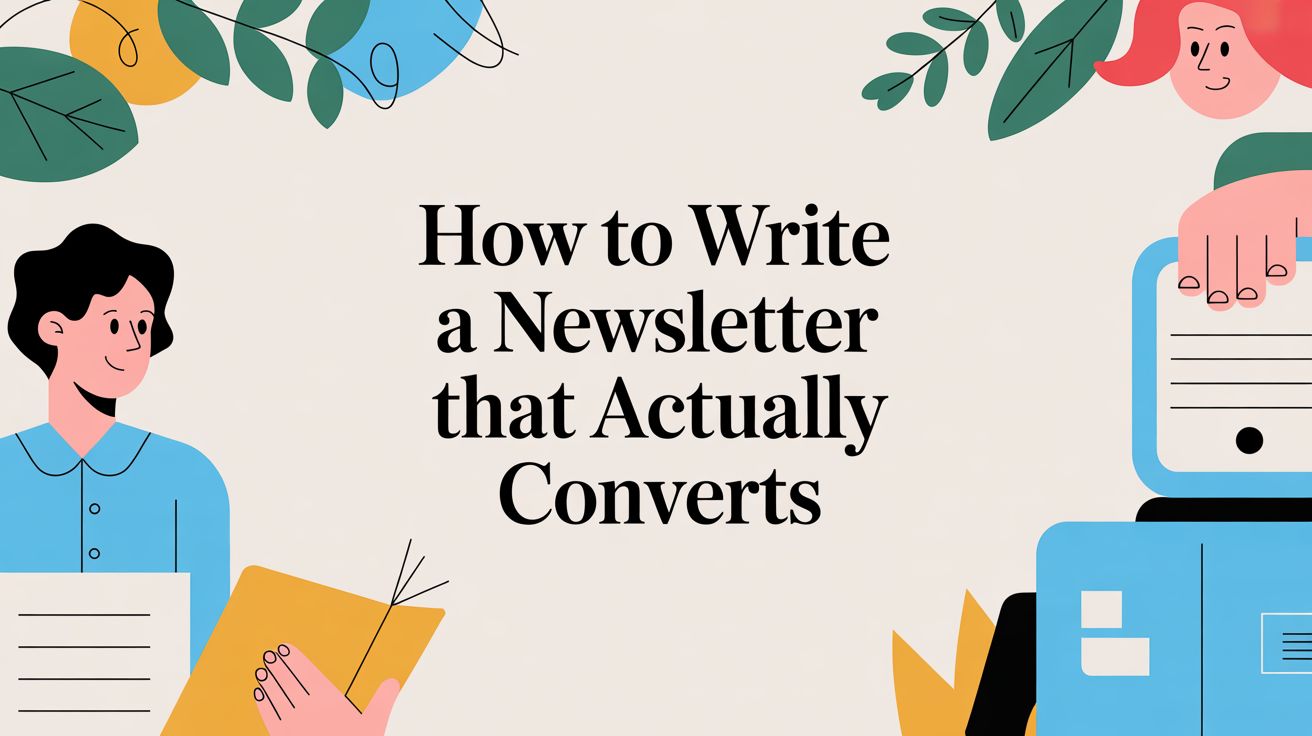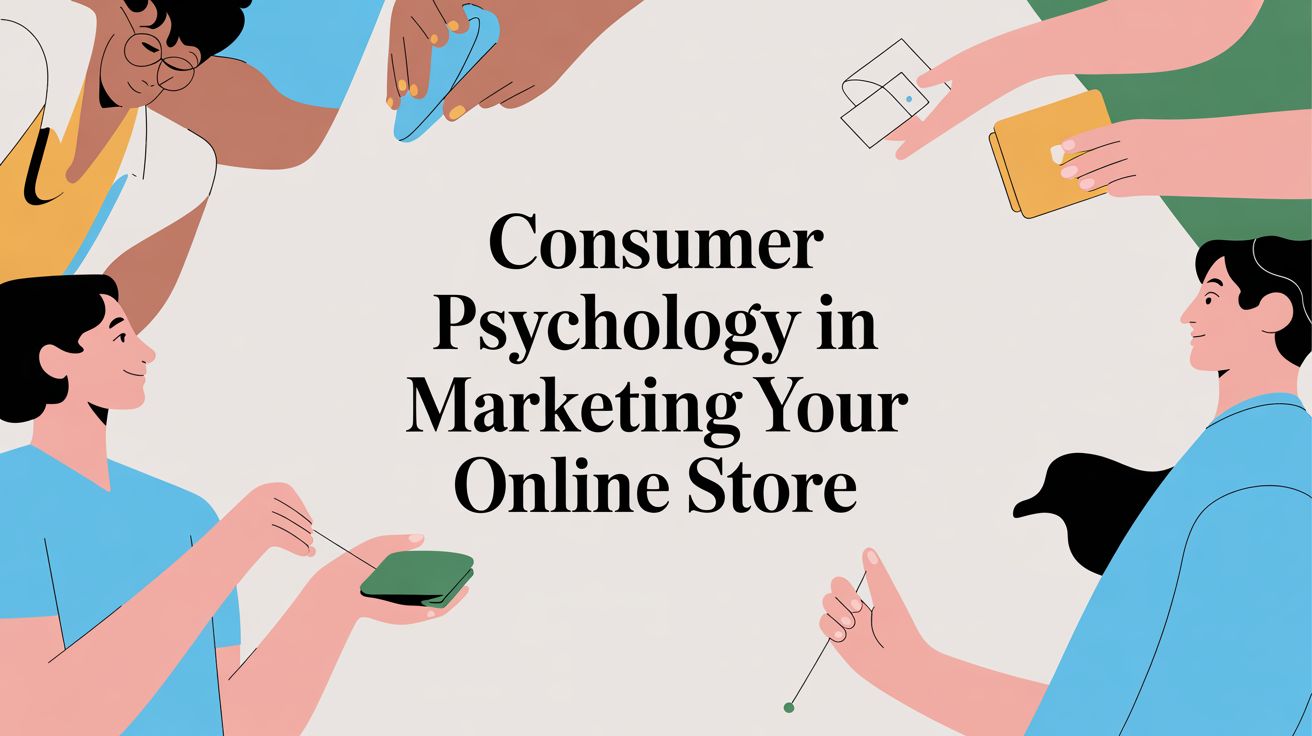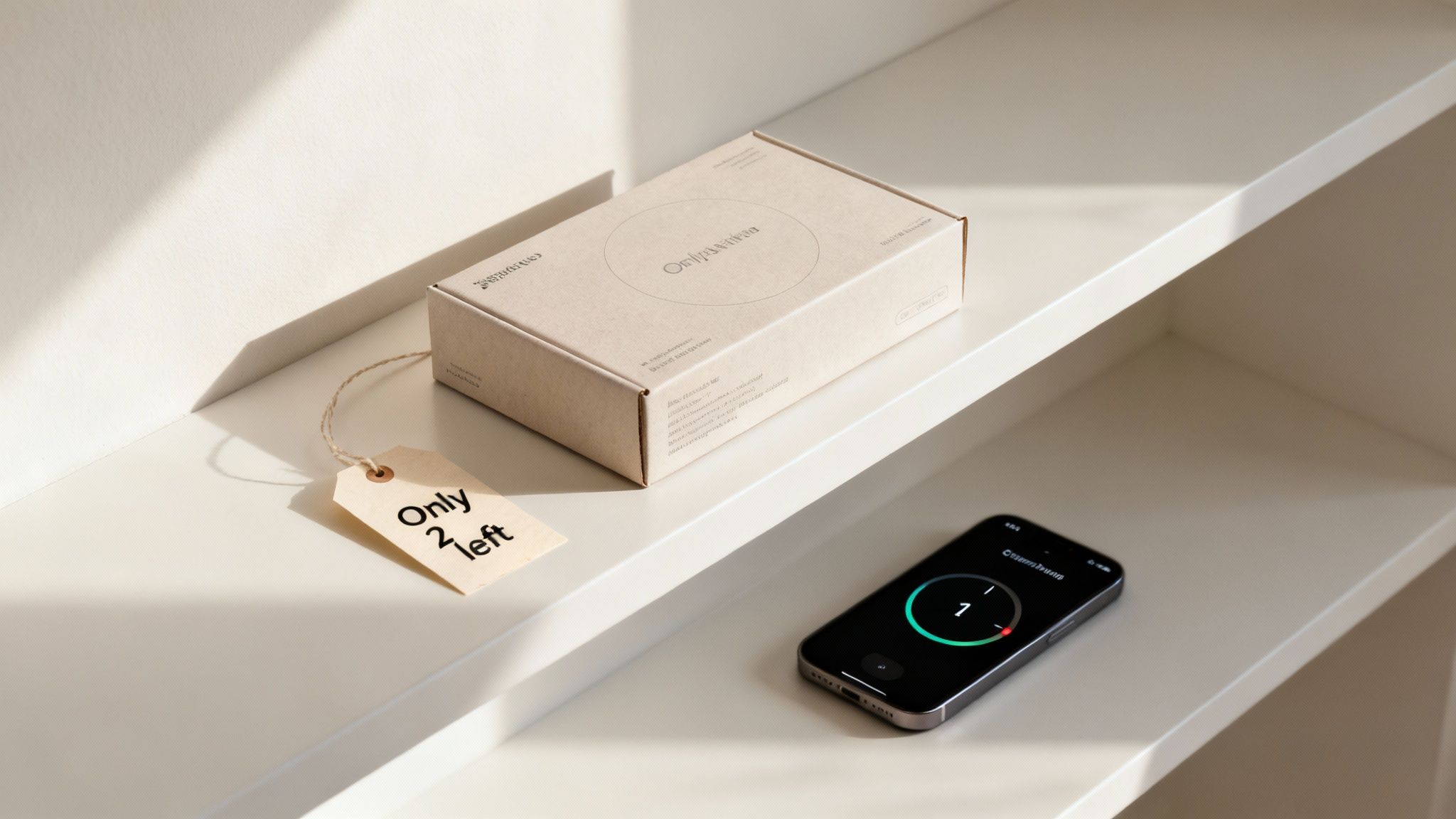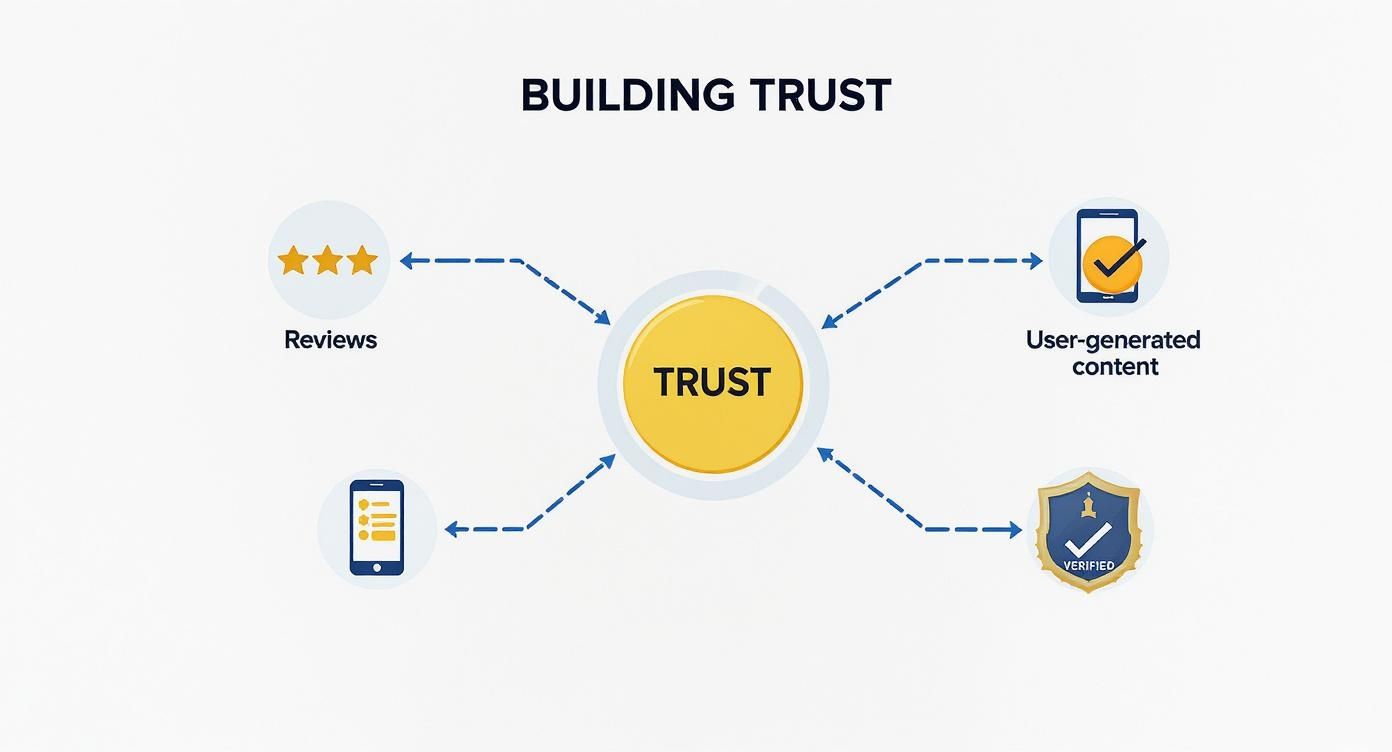
The Science of Shopping: A Guide to Consumer Psychology in Marketing

Ever wonder why people choose one product over another, even when they look almost identical? It's rarely a logical, side-by-side comparison. The real decision happens below the surface, driven by subconscious thoughts, gut feelings, and mental shortcuts. Consumer psychology in marketing is the science of understanding those hidden drivers. When you know what makes your customers tick, you can stop guessing and start creating marketing that genuinely connects, driving revenue and protecting profit margins.
Understanding the Hidden Drivers of Buying Decisions

Here's a fascinating truth from behavioral economics: most shoppers can't even tell you why they made the choice they did.
There’s a classic study where people consistently chose stockings from the right side of a display. Yet when asked why, they invented reasons about quality or texture—not one mentioned the position. This reveals a huge disconnect in marketing: what customers say they want often has little to do with what actually motivates them to buy. This is where the real ROI is found. Instead of just chasing clicks, the smartest marketers are obsessed with the "why" behind every action.
Core Principles Shaping Consumer Behavior
At its core, consumer psychology isn't about manipulation; it's about applying proven behavioral science to make the customer's journey more intuitive. A few key principles are the foundation for everything:
- Loss Aversion: The fear of losing something feels about twice as powerful as the pleasure of gaining it. Think about free trials—once a customer has your product, the idea of having it taken away is a massive motivator to subscribe.
- Social Proof: We are social creatures. We look to others to figure out what to do. When you see a restaurant with a line out the door or a product with thousands of glowing reviews, you instinctively trust it's a good choice.
- Scarcity: We want what we can't have, or what we might not be able to have soon. "Limited edition" drops and "while supplies last" offers create an instant jolt of desire—the Fear of Missing Out (FOMO)—to act before the opportunity vanishes.
Featured Snippet Opportunity: What is consumer psychology in marketing? Consumer psychology in marketing is the study of how people's thoughts, beliefs, feelings, and perceptions influence their buying behavior. It applies principles from behavioral economics and psychology, like scarcity, social proof, and loss aversion, to create more effective and resonant marketing strategies that drive revenue.
To tap into these drivers, you first need to know who you're talking to. That’s why it’s so critical to learn how to create buyer personas that drive growth. This foundational work helps you pinpoint the exact psychological triggers that will resonate with your specific audience. From there, you can build campaigns that speak directly to subconscious motivations, protecting your profit margins because you're no longer relying on deep discounts to get attention.
Actionable Takeaway: Audit your top product pages. Are you using language that triggers loss aversion ("Don't miss out") or highlights social proof ("Join 10,000 happy customers")? Test different phrases in your call-to-action buttons.
Using Scarcity and Urgency To Drive Action

If loss aversion is the fear of losing what you have, scarcity and urgency are its forward-looking cousins. They tap directly into the fear of missing out (FOMO) on something you could have. It’s a powerful psychological trigger that behavioral economics has proven time and again: we place a much higher value on things that are rare or about to disappear.
This isn't just theory. The average ecommerce store sees nearly 70% of shopping carts abandoned. That’s a staggering amount of potential revenue walking away. Urgency and scarcity give customers a compelling reason to complete the purchase now instead of putting it off for "later"—a moment that often never comes. The problem is, a generic countdown timer slapped on a product page no longer works. Modern shoppers are savvy. To generate real revenue, your approach must be sophisticated psychology, not manipulation.
The Science Behind Scarcity Marketing
At its core, scarcity signals value and exclusivity. When something is in short supply, our brain automatically assumes it's more desirable. This isn't about tricking people; it's about framing your products in a way that aligns with human psychology.
Limited Quantity Scarcity: This is the most straightforward play. Showing real-time stock levels—like "Only 3 left!"—creates genuine scarcity. For Shopify merchants, this can be automated by connecting display banners to your actual inventory data, which keeps the message honest and builds trust. This is a simple, effective tactic for inventory management.
Limited Edition Scarcity: Think exclusive product drops or special collaborations. Here, the value isn't just the product itself, but its rarity. This is a fantastic way to protect profit margins, as customers will often pay a premium for something truly unique.
The real power of scarcity is how it reframes the customer’s internal dialogue. It shifts their thinking from, "Should I buy this?" to, "If I want this, I have to buy it now." That subtle change can bypass the lengthy consideration phase of the buyer journey, directly boosting revenue.
Platforms like Quikly position themselves as experts in this science, helping brands create "Moments"—dynamic campaigns that go beyond basic timers. For a deeper dive, check out this guide on consumer psychology and why urgency causes action.
Elevating Urgency Beyond The Countdown Clock
Urgency creates a time-bound reason to act. While a ticking clock is an obvious tool, effective strategies connect urgency to specific customer actions. This is how you move beyond basic pop-up apps designed for email capture and start building real revenue-generating events. Quikly enhances banners, popups, and the entire shopper's journey by grounding them in these advanced behavioral triggers.
Actionable Strategies for Your Store:
Create Tiered, Time-Sensitive Offers: Instead of a single flat discount, build a sense of competition. A Quikly campaign, for example, might offer 40% off to the fastest 100 people and 20% off to the next 500. This gamifies the experience and creates a powerful incentive to act immediately.
Integrate Urgency With Your Tech Stack: Connect your urgency campaigns to tools like Klaviyo or your SMS platform. Sending a notification that a limited-time offer is about to drop can drive a massive wave of high-intent traffic to your Shopify store at the exact right moment.
Use Urgency for Smart Inventory Management: Have excess stock of a certain product? Run a targeted "flash sale" just for that item. You'll generate immediate revenue and clear out old inventory without resorting to a site-wide, margin-crushing discount.
When grounded in genuine scarcity and engaging events, urgency becomes a sophisticated engine for generating revenue that respects customers while driving action.
Building Trust with Social Proof and Authority
When we’re unsure what to do, what's our first instinct? We look at what everyone else is doing. In marketing psychology, this mental shortcut is called social proof. You're far more likely to enter a buzzing restaurant than the empty one next door. The logic is simple—if all those people chose it, it must be good.
For an ecommerce brand, this principle is gold. Shoppers can’t hold your product, so they seek reassurance they’re making a good choice. They rely on the experiences of others to quiet their doubt. This isn’t about just slapping a few testimonials on your site; it’s about weaving a web of trust around your brand so buying from you feels like the safest, smartest move.
The Different Forms of Social Proof
Social proof isn’t one-size-fits-all. A smart strategy layers multiple types of validation to build an undeniable case for your brand.
User Reviews and Ratings: The most direct form of social proof. For stores on platforms like Shopify, using apps from partners like Yotpo or Loox to display star ratings and reviews on product pages is non-negotiable. It provides an instant, peer-to-peer gut check.
User-Generated Content (UGC): Nothing beats seeing real people enjoying your products. Encourage customers to share photos on Instagram with a special hashtag, then feature that authentic content on your site. It instantly moves you beyond sterile product shots.
Expert Endorsements and Authority: When an expert, publication, or respected industry group gives your product a nod, their credibility instantly transfers to you. This could be a feature in a popular blog or a seal of approval from a trusted voice in your niche.
At its heart, social proof answers one subconscious question for your shopper: "Do people like me buy this, and are they happy they did?" When you can make the answer a clear "yes," the path to purchase gets a whole lot smoother.
From Celebrity Endorsements to Authentic Influence
The concept of "authority" has evolved. While celebrity ads still exist, today’s shoppers seek recommendations from people they find more relatable. This move toward authenticity is a massive trend in consumer psychology in marketing.
Just look at the rise of influencer marketing. A staggering 49% of Gen Alpha users trust influencers for product tips as much as they trust their own family and friends. Gen Z is right there with them, far more likely to be swayed by a social media account than a traditional ad. This is driven by a deep desire for genuine connection. To dig into more of these behavioral shifts, you can discover more insights on Netguru.com.
Micro-influencers—creators with smaller but fiercely loyal followings—really shine here. A recommendation from them feels like a hot tip from a friend, not a paid advertisement. For many brands, partnering with a handful of these micro-influencers can create a much more authentic buzz (and better ROI) than one pricey campaign with a mega-influencer. If you're curious about why our brains react this way, you can read more in our article on the brain science behind social proof.
Actionable Takeaway: On your product pages, place a powerful, benefit-driven customer review directly below the "Add to Cart" button. This provides immediate reassurance at the most critical point of decision.
Solving the Paradox of Choice with AI Personalization
Ever stand in a store aisle, staring at a wall of similar products, feeling totally paralyzed? That sense of paralysis from having too many options is a very real phenomenon called the paradox of choice. When faced with endless possibilities, we often choose nothing at all.
For an online store, this translates directly to decision fatigue, shopper anxiety, and sky-high cart abandonment rates. This is where modern AI becomes a powerful tool grounded in human psychology. By analyzing user behavior, AI can intelligently narrow the field of options, guiding shoppers to the products that actually matter to them. It's not just about showing them things they've clicked on; it's about predicting what they'll love next.
Moving Beyond Basic Recommendation Engines
For years, ecommerce personalization was about simple widgets like "Customers who bought this also bought..." These tools were basic and never understood the deeper why behind a shopper's journey.
Advanced AI, on the other hand, is like having a skilled personal shopper. It analyzes behavioral triggers in real-time—clicks, hover time, search terms, even mouse movements—to build a dynamic profile of what the customer wants right now. This creates a hyper-personalized experience that feels less like a clunky algorithm and more like a genuinely helpful guide.
This infographic shows how building trust is a critical first step. When you combine elements like reviews, user-generated content, and signs of authority, your AI recommendations become much more effective.

By layering in these trust signals, AI-driven personalization can cut through skepticism and guide shoppers with a more confident hand.
How AI Reduces Friction and Boosts AOV
The biggest business impact of solving the paradox of choice is a massive reduction in friction. When a shopper lands on a product page and is immediately shown the perfect accessories or alternate colors that match their browsing history, the path to checkout feels natural and easy.
This sophisticated approach has a major impact on key business metrics:
- Increased Average Order Value (AOV): By showing relevant add-ons and upsells that truly solve a problem, AI-powered tools encourage bigger, more valuable carts, directly improving ROI.
- Improved Conversion Rates: When you reduce decision fatigue, more visitors finish their purchase. The industry average conversion rate sits around 2.5%; smart personalization can significantly outperform this benchmark.
- Enhanced Customer Loyalty: A shopping experience that feels tailor-made builds a strong emotional connection, bringing people back far more effectively than another generic discount.
For Shopify Plus merchants, this level of intelligence is a competitive must-have. For a deeper look at the tools out there, check out our guide on top-tier ecommerce personalization software.
Actionable Takeaway: Use a personalization app on your Shopify store to recommend products based not just on what a user has viewed, but on what similar users have purchased. This leverages social proof within your personalization strategy.
Adapting to the New Post-Pandemic Shopper Mindset
The last few years didn’t just change where people shop; they rewired how people think about shopping. The modern consumer's brain is a mix of caution and aspiration, creating a new challenge for brands.
Today’s shoppers have a split personality. On one hand, they’re more price-conscious, hunting for deals and ensuring every dollar is well-spent. On the other, they’re making more intentional, values-driven purchases, actively seeking brands that align with their personal beliefs. If you lean too hard on discounts, you kill your margins. If you only talk about your premium brand story, you seem out of touch. The key is finding a way to address both halves of this new consumer brain.
The Duality of Frugality and Values
The new shopper is a master of selective spending. They'll clip coupons for groceries but won't blink at investing in a product from a brand they believe in. This isn't a contradiction—it's a more sophisticated definition of value. Value isn't just the lowest price; it’s the whole package: product quality, brand ethics, and a gut feeling of connection.
This mental shift means your marketing must be more nuanced. You have to blend the rational with the emotional, proving your product is worth the money from a practical standpoint while also telling a story that resonates on a deeper level.
A recent McKinsey survey drives this home, showing how much these new habits have stuck. People are digging deeper online before they buy, with 32% of consumers now using social media to vet products. The report also found that 57% of shoppers actively seek deals but will still splurge on categories they care about. It’s a perfect snapshot of this new, more complex dance between the brain and the heart.
Actionable Strategies for the Modern Shopper
Navigating this new world with a one-size-fits-all campaign is a recipe for failure. Instead, brands must work harder to build trust and prove their worth.
- Lead with Transparent Value: Instead of just slapping a percentage off the price, frame offers around clear, tangible value. Product bundles, "buy one, get one" deals, or a free gift with purchase feel more substantial and protect your brand's perceived worth and profit margins.
- Double Down on Brand Storytelling: Your "About Us" page is prime real estate. Use it, along with social media and emails, to communicate what your brand stands for. Are you about sustainability? Quality craftsmanship? Giving back? This is how you connect with the values-driven side of your customer.
- Amplify Social Proof and Reviews: With everyone doing their homework, authentic testimonials and user-generated content are gold. They offer the crucial third-party approval that satisfies both the rational need for a good product and the emotional need for a trustworthy choice.
The post-pandemic shopper isn't just a bargain hunter; they are a discerning investor. Your marketing must respect that intelligence by offering genuine value while building an emotional connection that goes beyond the price tag.
For merchants on a platform like Shopify Plus, this means getting smart with segmentation. You can use an integration with Klaviyo to send special offers to your price-sensitive audience while sharing your brand's mission with a more values-focused segment.
Your Action Plan for Applying Consumer Psychology
Knowing the theories is one thing, but using that knowledge to grow revenue is another. Let's break down how to turn these concepts into a practical framework for your Shopify store, moving from theory to tangible business impact. The goal is to pinpoint the exact moments in your customer's journey where a psychologically-driven message can make the biggest difference to your ROI.
First, Audit Your Customer Journey
Before launching a new campaign, look at your existing flow. Where are people dropping off? With the average cart abandonment rate hovering around 70%, the biggest leaks are likely happening right before the finish line.
Product Detail Pages (PDPs): How are you using social proof? It's not enough to have a star rating. Integrate dynamic review widgets and showcase real user-generated content. This reduces purchase anxiety by showing that people like your customer have bought and loved the product.
Cart and Checkout: This is prime time for loss aversion. Once an item is in the cart, the customer has started to take mental ownership. Remind them what they stand to lose. A simple phrase like, "Complete your order before it's gone," is far more compelling than a generic "Checkout."
Post-Visit Communication: What about visitors who leave without buying? This is where sophisticated automation shines. Instead of a basic timer app, advanced urgency marketing can trigger personalized follow-ups that address specific hesitations.
A good audit will highlight key friction points. These aren't problems; they're opportunities. Each one is a chance for a well-timed urgency trigger or a burst of social proof to prevent a sale from slipping away.
Implement and Segment with Precision
Once you've identified those critical moments, it's time to act. As you build out your action plan, ground your efforts in proven tactics by exploring effective ecommerce conversion rate optimisation tips.
For Shopify Plus merchants, precision is everything. Use tools like Klaviyo to segment your audience and deliver messages that resonate. A first-time visitor might be swayed by social proof, while a loyal customer could be motivated by an exclusive, time-sensitive offer. This is a world away from a basic email capture pop-up that only captures a lead without driving immediate revenue.
By weaving in platforms like Quikly, you can automate these "Moments." You're creating dynamic, behavior-based campaigns that generate revenue without manual management. This strategic application of consumer psychology in marketing flips the script, turning a passive browsing session into an engaging experience that encourages action. The result isn't just a higher conversion rate—it's a measurable lift in ROI and stronger customer relationships.
Common Questions About Consumer Psychology
You understand the core principles. But how do you put them into practice ethically and in a way that actually moves the needle? Let's walk through some of the most common questions.
Is This Stuff Manipulative?
That's a fair question, and the answer boils down to intent. Ethical marketing uses psychological insights to make the customer's life easier. Signaling that an item is almost out of stock helps someone who wants it avoid disappointment. You're adding value and reducing friction.
Manipulation, on the other hand, is deception. It's inventing fake urgency or making misleading claims to trick someone into a quick sale. The goal of sophisticated psychology in marketing should always be building a long-term relationship based on trust, not exploiting a trigger for a short-term win.
How Can a Small Shopify Store Use This on a Tight Budget?
You don't need a massive budget. Some of the most powerful psychological tactics are about creativity, not cash. Small Shopify stores can see a huge lift from a few smart, low-cost tweaks.
- Rethink Your Product Descriptions: Use language that hints at scarcity ("Limited batch," "Small run") or social proof ("A customer favorite," "Over 1,000 sold this season").
- A/B Test Your CTAs: It costs nothing to experiment. Try changing "Add to Cart" to something with more urgency, like "Buy Now Before It's Gone," and measure the impact on conversions.
- Get Smart with Your Email: If you're using a tool like Klaviyo, set up abandoned cart reminders that play on loss aversion. Gently remind them what they're leaving behind.
What's the Single Most Impactful Principle for Boosting Revenue?
Every store is different, but if we had to pick one, it's urgency. Why? Because it directly tackles the biggest profit killer in ecommerce: procrastination.
Think about it. The industry benchmark for cart abandonment hovers around a staggering 70%. That means the vast majority of people who are interested enough to add your product to their cart just leave.
Urgency, driven by real scarcity and FOMO, gives shoppers a compelling reason to act now. It's the antidote to "I'll come back later." When you move beyond a basic countdown timer and build sophisticated, automated campaigns around it, you directly combat hesitation, speed up the sales cycle, and turn browsers into buyers. It's a critical lever for protecting your profit margins and keeping inventory moving.
Ready to move beyond basic popups and countdown timers? See how Quikly uses the science of urgency marketing to create high-impact campaigns that drive measurable ROI and engage your customers. Discover the difference at https://hello.quikly.com.

The Quikly Content Team brings together urgency marketing experts, consumer psychologists, and data analysts who've helped power promotional campaigns since 2012. Drawing from our platform's 70M+ consumer interactions and thousands of successful campaigns, we share evidence-based insights that help brands create promotions that convert.
